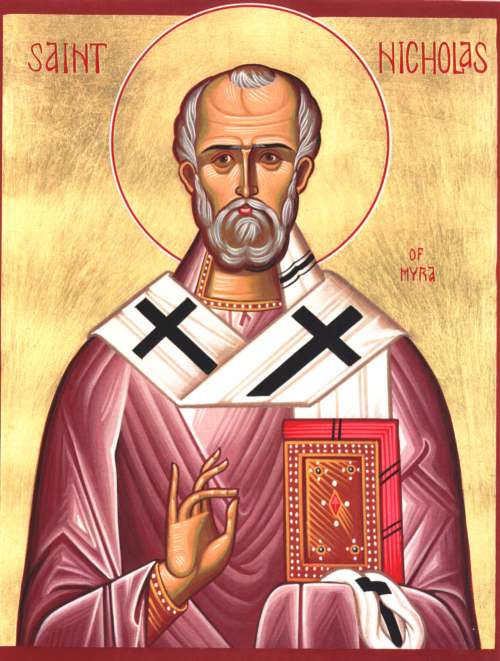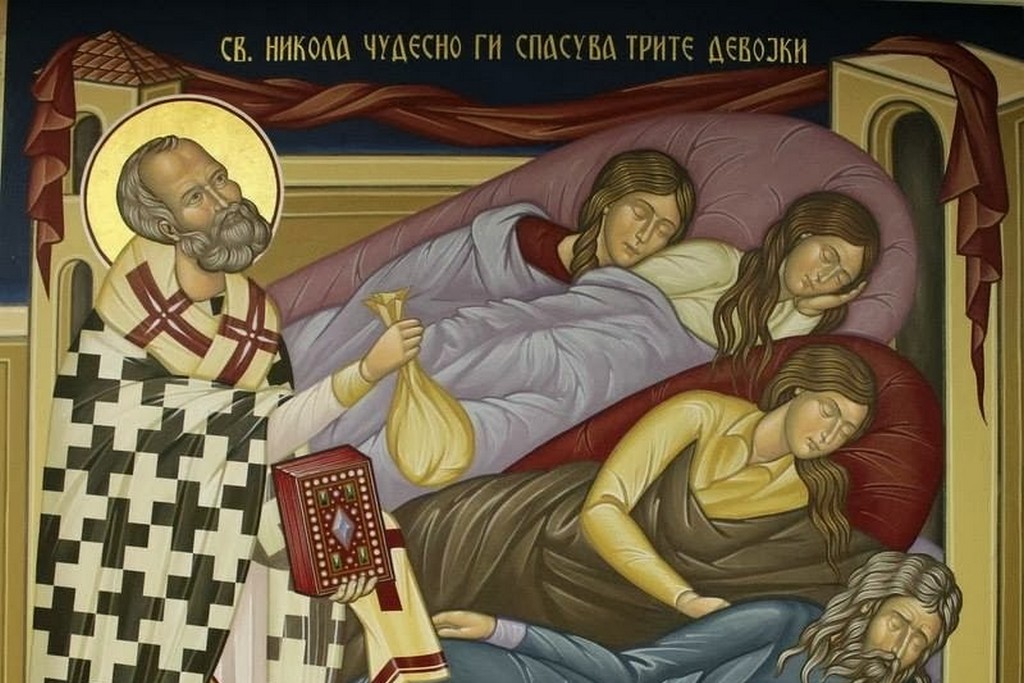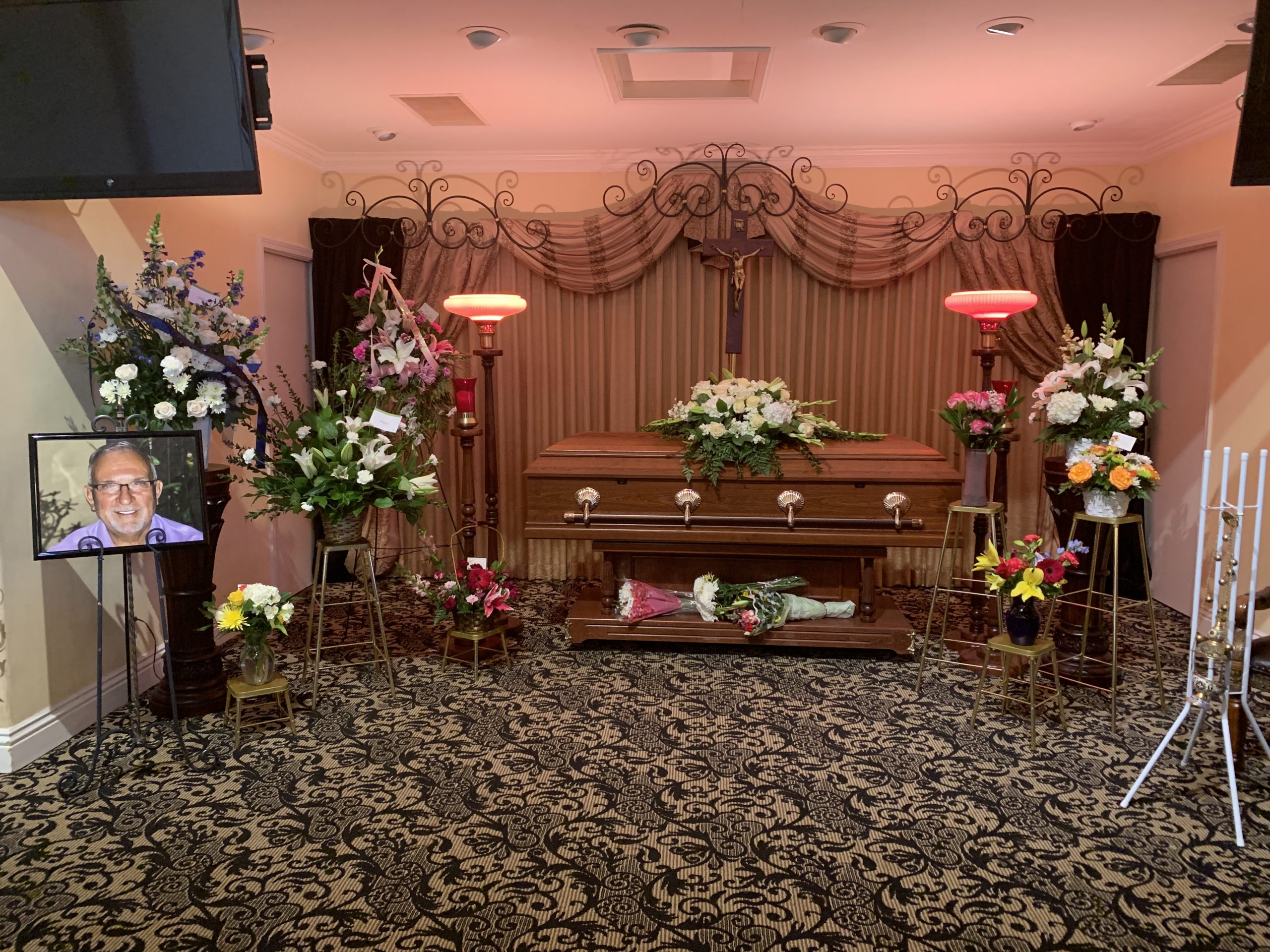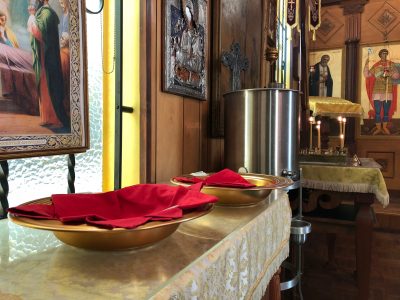 Saint Nicholas is famed as a great saint pleasing unto God. He was born in the city of Patara in the region of Lycia (on the south coast of the Asia Minor peninsula), and was the only son of pious parents, Theophanes and Nonna, who had vowed to dedicate him to God. As the fruit of the prayer of his childless parents, the infant Nicholas from the very day of his birth revealed to people the light of his future glory as a wonderworker. His mother, Nonna, after giving birth, was immediately healed from illness. The newborn infant, while still in the baptismal font, stood on his feet three hours, without support from anyone, thereby honoring the Most Holy Trinity. From his infancy, he began a life of fasting and on Wednesdays and Fridays, he would not accept milk from his mother until after his parents had finished their evening prayers.
Saint Nicholas is famed as a great saint pleasing unto God. He was born in the city of Patara in the region of Lycia (on the south coast of the Asia Minor peninsula), and was the only son of pious parents, Theophanes and Nonna, who had vowed to dedicate him to God. As the fruit of the prayer of his childless parents, the infant Nicholas from the very day of his birth revealed to people the light of his future glory as a wonderworker. His mother, Nonna, after giving birth, was immediately healed from illness. The newborn infant, while still in the baptismal font, stood on his feet three hours, without support from anyone, thereby honoring the Most Holy Trinity. From his infancy, he began a life of fasting and on Wednesdays and Fridays, he would not accept milk from his mother until after his parents had finished their evening prayers.
From his childhood, Nicholas thrived on the study of Diving Scripture; by day he would not leave church and by night, he prayed and read books, making himself a worthy dwelling place for the Holy Spirit. Bishop Nicholas of Patara rejoiced at the spiritual success and deep piety of his nephew. He ordained him a reader, and then elevated Nicholas to the priesthood, making him his assistant and entrusting him to instruct the flock. In serving the Lord, the youth was fervent of spirit, and in his proficiency, with questions of faith he was like an Elder, who aroused the wonder and deep respect of believers. Constantly at work and vivacious in unceasing prayer, the priest Nicholas displayed great kindheartedness towards the flock, and towards the afflicted who came to him for help, and he distributed all his inheritance to the poor.
There was a certain formerly rich inhabitant of Patara, whom St. Nicholas saved from great sin. The man had three grown daughters and, in desperation, planned to sell their bodies so they would have money for food. The saint, upon learning of the man’s poverty and of his wicked intention, secretly visited him one night and threw a sack of gold through the window. With the money the man arranged an honorable marriage for his daughter. St. Nicholas also provided gold for the other daughters, thereby saving the family from falling into spiritual destruction. In bestowing charity, St. Nicholas always strove to do this secretly to conceal his good deeds.
The Bishop of Patara decided to go on pilgrimage to the holy places at Jerusalem, and entrusted the guidance of his flock to St. Nicholas who fulfilled this obedience carefully and with love. When the bishop returned, Nicholas asked his blessing for a pilgrimage to the Holy Land. Along the way, the saint predicted a storm would arise and threaten the ship. St. Nicholas saw the devil get on the ship, intending to sink it and kill all the passengers. At the entreaty of the despairing pilgrims, he calmed the waves of the sea by his prayers. Through his prayer a certain sailor of the ship, who had fallen from the mast and was mortally injured, was also restored to health.When he reached the ancient city of Jerusalem and came to Golgotha, St. Nicholas gave thanks to the Savior. He went to all the holy places, worshiping at each one. One night on Mount Sion, the closed doors of the church opened by themselves for the great pilgrim. Going round the holy places connected with the earthly service of the Son of God, St. Nicholas decided to withdraw into the desert, but he was stopped by a diving voice urging him to return to his native country. He returned to Lycia and, yearning for a life of quietude, the saint entered into the brotherhood of a monastery named Holy Sion, which had been founded by his uncle. But the Lord again indicated another path for him, “Nicholas, this is not the vineyard where you shall bear fruit for Me. Return to the world, and glorify My Name there.” So he left Patara and went to Myra in Lycia.
Upon the death of Archbishop John, Nicholas was chosen as Bishop of Myra after one of the bishops of the Council said that a new archbishop should be revealed by God, not chosen by men. One of the elder bishops had a vision of a radiant Man, who told him that the one who came to the church that night and was first to enter should be made archbishop. He would be named Nicholas. The bishop went to the church at night to await Nicholas. The saint, always the first to arrive at church, was stopped by the bishop. “What is your name, child?” he asked. God’s chosen one replied, “My name is Nicholas, Master, and I am your servant.” After his consecration as archbishop, St. Nicholas remained a great ascetic, appearing to his flock as an image of gentleness, kindness, and love for people. This was particularly precious for the Lycian Church during the persecution of Christians under the emperor Diocletian (284-305). Bishop Nicholas, locked up in prison together with other Christians for refusing to worship idols, sustained them and exhorted them to endure the fetters, punishment and torture. The Lord preserved him unharmed. Upon the accession of St. Constantine (May 21) as emperor, St. Nicholas was restored to his flock, which joyfully received their guide and intercessor.
Despite his great gentleness of spirit and purity of heart, St. Nicholas was a zealous and ardent warrior of the Church of Christ. Fighting evil spirits, the saint made the rounds of the pagan temples and shrines in the city of Myra and its surrounding, shattering the idols and turning the temples to dust. In the year 325, St. Nicholas was a participant in the First Ecumenical Council. This Council proclaimed the Nicean Symbol of Faith, and he stood up against the heretic Arius with the likes of Sts Sylvester the Bishop of Rome (January 2), Alexander of Alexandria (May 29), Spyridon of Trimythontos (December 12), and other Fathers of the Council. St. Nicholas, fired with zeal for the Lord, assailed the heretic Arius with his words, and also struck him upon the face. For this reason, he was deprived of the emblems of his episcopal rank and placed under guard. But several of the holy Fathers had the same vision, seeing the Lord Himself and the Mother of God returning to him the Gospel and omophorion. The Fathers of the Council agreed that the audacity of the saint was pleasing to God, and restored the saint to the office of bishop.
Having returned to his own diocese, the saint brought it peace and blessings, sowing the word of Truth, uprooting heresy, nourishing his flock with sound doctrine, and also provided food for their bodies.
Even during his life the saint worked many miracles. One of the greatest was the deliverance from death of three men unjustly condemned by the Governor, who had been bribed. The saint boldly went up to the executioner and took his sword, already suspended over the heads of the condemned. The Governor, denounced by St Nicholas for his wrong doing, repented and begged for forgiveness. Witnessing this remarkable event were three military officers who were sent to Phrygia by the emperor Constantine to put down a rebellion. They did not suspect that soon they would also be compelled to seek the intercessions of St. Nicholas. Evil men slandered them before the emperor, and the officers were sentenced to death. Appearing to St. Constantine in a dream, St. Nicholas called on him to overturn the unjust sentence of the military officers.
He worked many other miracles, and struggled many long years at his labor. Through the prayers of the saint, the city of Myra was rescued from a terrible famine. He appeared to a certain Italian merchant and left him three gold pieces as a pledge of payment. He requested him to sail to Myra and deliver grain there. More than once, the saint saved those drowning in the sea, and provided release from captivity and imprisonment.
Having reached old age, St. Nicholas peacefully fell asleep in the Lord. His venerable relics were preserved incorrupt in the local cathedral church and flowed with curative myrrh, from which many received healing. In the year 1087, his relics were transferred to the Italian city of Bari, where they rest still today (see May 9).
The name of the great saint of God, the hierarch and wonderworker Nicholas, a speedy helper and supplicant for all hastening to him, is famed in every corner of the earth, in many lands and among many peoples. In Russia, there are a multitude of cathedrals, monasteries, and churches consecrated in his name. There is, perhaps, not a single city without a church dedicated to him.
The first Russian Christian prince Askold (+882) was baptized in 866 by Patriarch Photius (Feb 6) with the name Nicholas. Over the grave of Askold, St. Olga (July 11) built the first temple of St. Nicholas in the Russian Church at Kiev. Primary cathedrals were dedicated to St. Nicholas at Izborsk, Ostrov, Mozhaisk, and Zaraisk. At Novgorod the Great, one of the main churches of the city, the Nikolo-Dvorischensk church, later became a cathedral. Famed and venerable churches and monasteries dedicated to St. Nicholas are found at Kiev, Smolensk, Pskov, Toropetsa, Galich, Archangelsk, Great Usting, Tobolsk. Moscow had dozens of churches named for the saint, and also three monasteries in the Moscow diocese: the Nikolo-Greek (Staryi) in the Chinese-quarter, the Nikolo-Perevinsk and the Nikolo-Ugreshsk. One of the chief towers of the Kremlin was named the Nikolsk.
Many of the churches devoted to the saint were those established at marked squares by Russian merchants, sea-farers and those who traveled by land, venerating the wonderworker Nicholas as a protector of all those journeying on fry land and sea. They sometimes received the name among the people of “Nicholas soaked.”
Many village churches in Russia were dedicated to the wonderworker Nicholas, venerated by peasants as a merciful intercessor before the Lord for all the people in their work. And in the Russian land St. Nicholas did not cease his intercession. Ancient Kiev preserves the memory about the miraculous rescue of a drowning infant by the saint. The great wonderworker, hearing the grief-filled prayers of the parents for the loss of their only child, took the infant from the waters, revived him and placed him in the choir-loft of the church of Holy Wisdom (Hagia Sophia) before his wonderworking icon. In the morning the infant was found safe by his thrilled parents, praising St. Nicholas the Wonderworker.
Many wonderworking icons of St. Nicholas appeared in Russia and came also from other lands. There is the ancient Byzantine embroidered image of the saint brought to Moscow from Novgorod, and the large icon painted in the thirteenth century by a Novgorod master. Two depictions of the wonderworker are especially numerous in the Russian Church: St. Nicholas of Zaraisk, portrayed in full-length, with his right hand raised in blessing and with a Gospel (this image was brought to Ryazan in 1225 by the Byzantine Princess Eupraxia, the future wife of Prince Theodore. She perished in 1237 with her husband and infant son during the incursion of Batu); and St. Nicholas of Mozhaisk, also in full stature, with a sword in his right hand and a city in his left. This recalls the miraculous rescue of the city of Mozhaisk from an invasion of enemies, through the prayers of the saint. It is impossible to list all the grace-filled icons of St. Nicholas, or to enumerate all his miracles.
St. Nicholas is the patron of travelers, and we pray to him for deliverance from floods, poverty, or any misfortunes. He has promised to help those who remember his parents, Theophanes, and Nonna. He is commemorated on May 9 (the transfer of his relics) and on July 29 (his nativity).
Святитель Николай, архиепископ Мир Ликийских, Чудотворец (перенесение мощей из Мир Ликийских в Бар).
В XI веке греческая империя переживала тяжелое время. Турки опустошали ее владения в Малой Азии, разоряли города и села, убивая их жителей, и сопровождали свои жестокости оскорблением святых храмов, мощей, икон и книг. Мусульмане покушались уничтожить мощи святителя Николая, глубоко чтимого всем христианским миром.
В 792 году калиф Аарон Аль-Рашид послал начальника флота Хумейда разграбить остров Родос. Опустошив этот остров, Хумейд отправился в Миры Ликийские с намерением взломать гробницу святителя Николая. Но вместо нее он взломал другую, стоявшую рядом с гробницей Святителя. Едва святотатцы успели это сделать, как на море поднялась страшная буря и почти все суда были разбиты.
Осквернение святынь возмущало не только восточных, но и западных христиан. Особенно опасались за мощи святителя Николая христиане в Италии, среди которых было много греков. Жители города Бар, расположенного на берегу Адриатического моря, решили спасти мощи святителя Николая.
В 1087 году барские и енецианские купцы отправились в Антиохию для торговли. И те и другие предполагали на обратном пути взять мощи святителя Николая и перевезти их в Италию. В этом намерении жители Бар опередили венецианцев и первыми высадились в Мирах. Вперед были посланы два человека, которые, вернувшись, сообщили, что в городе — все тихо, а в церкви, где покоится величайшая святыня, они встретили только четырех монахов. Тотчас 47 человек, вооружившись, отправились в храм святителя Николая, монахи-сторожа, ничего не подозревая, указали им помост, под которым была скрыта гробница святого, где, по обычаю, чужестранцев помазывали миром от мощей святителя. Монах рассказал при этом о явлении накануне святителя Николая одному старцу. В этом видении Святитель приказывал бережнее хранить его мощи. Рассказ этот воодушевил барян; они увидели для себя в этом явлении соизволение и как бы указание Святого. Чтобы облегчить свои действия, они открыли монахам свои намерения и предложили им выкуп — 300 золотых монет. Сторожа отказались от денег и хотели оповестить жителей об угрожавшем им несчастье. Но пришельцы связали их и поставили у дверей своих сторожей. Они разбили церковный помост, под которым стояла гробница с мощами. В этом деле особенным усердием отличался юноша Матфей, желавший как можно быстрее обнаружить мощи Святителя. В нетерпении он разбил крышку и баряне увидели, что саркофаг наполнен благоуханным святым миром. Соотечественники барян, пресвитеры Лупп и Дрого, совершили литию, после которой тот же Матфей стал извлекать из переполненного миром саркофага мощи Святителя. Это происходило 20 апреля 1087 года.
Ввиду отсутствия ковчега, пресвитер Дрого завернул мощи в верхнюю одежду и в сопровождении барян перенес их на корабль. Освобожденные монахи сообщили городу печальную весть о похищении ностранцами мощей Чудотворца. Толпы народа собрались на берегу, но было поздно…
8 мая корабли прибыли в Бар, и скоро радостная весть облетела весь город. На следующий день, 9 мая, мощи святителя Николая торжественно перенесли в церковь святого Стефана, находившуюся неподалеку от моря. Торжество перенесения святыни сопровождалось многочисленными чудотворными исцелениями больных, что возбуждало еще большее благоговение к великому угоднику Божию. Через год была построена церковь во имя святителя Николая и освящена папой Урбаном II.
Событие, связанное с перенесением мощей святителя Николая,вызвало особенное почитание Чудотворца и ознаменовалось установлением особого праздника 9 мая. Вначале праздник перенесения мощей святителя Николая отмечался только жителями итальянского города Бар. В других странах Христианского Востока и Запада он не был принят, несмотря на то, что о перенесении мощей было широко известно. Это обстоятельство объясняется свойственным средним векам обычаем чествования преимущественно местных святынь. Кроме того, Греческая Церковь не установила празднования этой памяти, потому что потеря мощей Святителя была для нее событием печальным.
Русской Православной Церковью празднование памяти перенесения мощей святителя Николая из Мир Ликийских в Бар 9 мая установлено вскоре после 1087 года на основе глубокого, уже упрочившегося почитания русским народом великого угодника Божия, перешедшего из Греции одновременно с принятием христианства. Слава о чудотворениях, явленных Святителем на земле и на море, была широко известна русскому народу. Их неистощимая сила и обилие свидетельствуют об особой благодатной помощи великого святого страждущему человечеству. Образ Святителя, всесильного Чудотворца-благотворителя, стал особенно дорог сердцу русского человека, потому что он вселил глубокую веру в него и надежду на его помощь. Бесчисленными чудотворениями ознаменовалась вера русского народа в неоскудеваемую помощь Угодника Божия.
В отечественной письменности очень рано составилась о нем значительная литература. Сказания о чудесах Святителя, совершенных на русской земле, стали записываться еще в глубокой древности. Вскоре после перенесения мощей святителя Николая из Мир Ликийских в Бар град, появилась русская редакция жития и повести о перенесении его святых мощей, написанной современником этого события. Еще ранее было написано слово похвальное Чудотворцу. Еженедельно, каждый четверг, Русская Православная Церковь особо чтит его память.
В честь святителя Николая воздвигались многочисленные храмы и монастыри, русские люди называли его именем своих детей при Крещении. В России сохранились многочисленные чудотворные иконы великого Святителя. Наиболее известные среди них образ Можайский, Зарайский, Волоколамский, Угрешский, Ратный. Нет ни одного дома и ни одного храма в Русской Церкви, в котором не было бы образа святителя Николая Чудотворца. Значение благодатного предстательства великого угодника Божия выражает древний составитель жития, по словам которого святитель Николай «многа великая и преславная чудеса сотвори на земли и на мори, в бедах сущим помогая и от потопления спасая, и из глубины морския на сухо износя, от тления восхищая и принося в дом, от уз и темниц избавляя, от мечнаго посечения заступая и от смерти свобождая, многим многая подаде исцеления: слепым зрение, хромым хождение, глухим слышание, немым глаголание. Многих в убожестве и нищете последней страдающих обогати, гладным пищу подаде и всякому во всякой потребе готовый помощник, теплый заступник и скорый предстатель и защитник показася, и овым такожде призывающим его помогает и от бед избавляет. Весть (знает) великаго Чудотворца сего Восток и Запад и все концы земнии ведят чудотворения его».
(Из “Настольной книги священнослужителя”)



